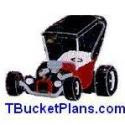One of the articles that I believe may have contributed to the Y-block's "Rodney Dangerfield" image. From Selecting & Building Hot Rod Engines by the editors of Hot Rod Magazine, 1964 :
In the last chapter we analyzed the compact lightweight V8's in the American hot rod picture. Now we're going to talk about the big boys. We arbitrarily define this group as those basic engines weighing more than 600 pounds with accessories (but no flywheel or clutch). FORD 239-312: This is the modern ohv V8 engine that Ford brought out in their 1954 cars. It was used in displacements all the way from 239 to 312 cubic inches and finally settled at 292 cubic inches as the standard V8 engine option for the '58-'62 models. In '63 it was replaced by the new Fairlane cast iron V8 (221-289 cubic inches). The engine is still being produced for commercial applications, but is no longer used in passenger cars. Actually this is a relatively small, light engine that is very handy for swaps. External dimensions compare with the small Chev V8 (a little larger), and weight is only a bit over 600 pounds with accessories (say 605). Transmission adaptors and motor mount kits are widely available. You can get all kinds of factory and special speed equipment. The things are plentiful and cheap in the junkyards. Factory parts over the counter are reasonable. It has everything ... Or everything except performance. The basic engine was never strong on power and torque. The '57 312-cubic-inch Thunderbird engines were the best of the bunch. They had pretty big valves and ports, and breathed fairly well. And this was the year Ford supplied the McCulloch supercharger kit for this engine. Holman & Moody pulled 340 hp at 5300 rpm from their 312 NASCAR engines with the blower. They could easily blow off the '57 fuel injection Chevys on the NASCAR tracks in the early part of the season. Then NASCAR officials banned blowers and f.i. A few weeks later, Detroit pulled out of racing and the 312 racing engines were dropped. In 1959 Ford went back to 292 cubic inches and small-port heads, and made an economy engine out of this. If you ever expect to perform with this basic engine you will definitely need a set of the '57 312 heads. Even then there were problems of valve shrouding by the close combustion chamber walls. You have to do a lot of grinding in the heads to get 'em to breathe right. Another limitation here is cubic inches. The 312 block can only be bored .075 inch and stroked 1/4. There's no more room -- and this gives only 348 cubic inches. That isn't very big these days. So I see the small Ford engine mostly for the boy on a shoestring who must pick up an engine cheap for a swap or something. It'll do the job here ... but don't count on it for all-out applications.
Subscribe to:
Post Comments (Atom)




No comments:
Post a Comment